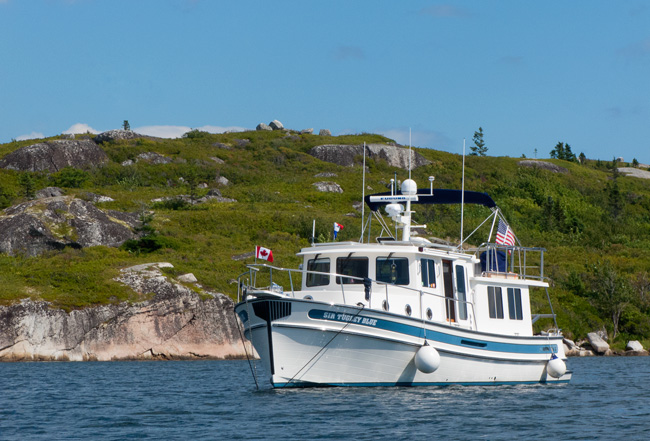Our Summer Cruise 2016
May 16 - 22 |
May 23 - 29 |
May 30 - Jun 5 |
Jun 6 - 12 |
Jun 13 - 19 |
Jun 20 - 26 |
Jun 27 - Jul 3 |
Jul 4 - 10 |
Jul 11 -17 |
Jul 18 - 24 |
Jul 25 - 31 |
Aug 1 - 7 |
Aug 8 - 14 |
Aug 15 -21 |
Aug 22 - 28 |
Aug 29 - Sep 4 |
Sep 5 - 11 |
Sep 12 - 18 |
Sep 19 - 25 |
Monday, August 22
Spent the day at Sally's Cove (Shelter Cove). We had planned on leaving early as a group for a run to Halifax but, when we got out of the protection of the Cove, the waves were a good size and on the beam; the boat rolling more than we like and 40+ miles to go, we decided to go back and anchor while the others went on. In our mind a good decision as they were rolling 20 degrees on the run.
The weather was very mixed with fog drifting in and out for much of the day although we did have some periods of sun. Wildlife was abundant today - Sammy the seal joined us on and off, we saw several porpoises playing in the cove and, late in the day, an eagle appeared overhead and flew from tree to tree looking for prey in the water.
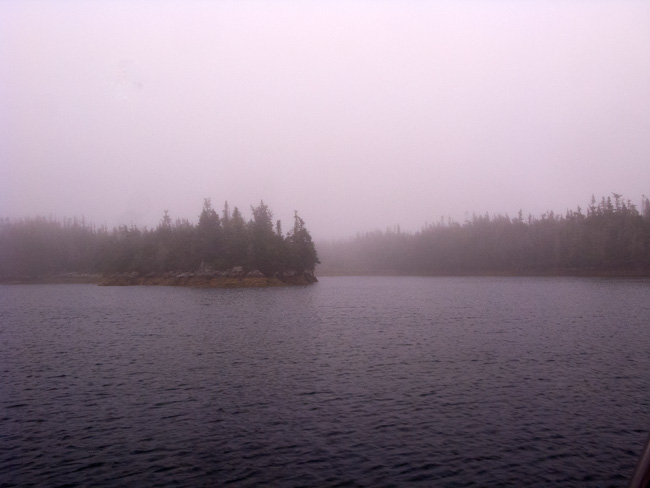
Sally's Cove in the Fog at Noon
The toilet pump was not working this morning when we were out in open water; I took the opportunity to strip it down again and found that the valves were likely shot so we will have to rely on pump outs for the rest of the season and get some parts on order.
Tuesday, August 23
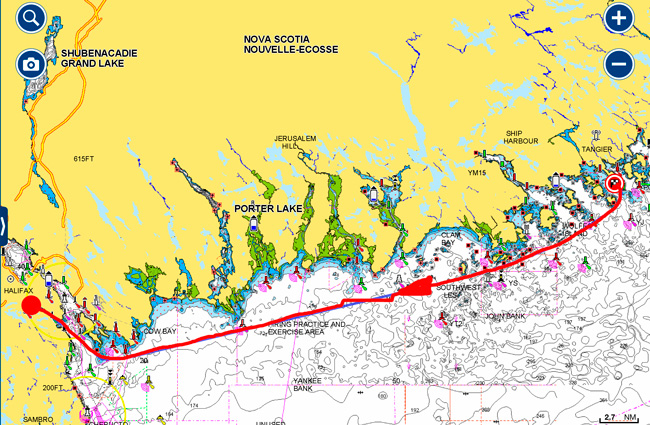
Sally's Cove (Shelter Cove) to Armdale Yacht Club, Halifax - 48nm
We were planning on leaving Sally's Cove around 7:30 am on a good sunny day with wind out of the West at 15 kts so pulled the anchor up to about 20' left to go and the windlass was starting to work very hard so I locked it and powered forward to break it loose but it just pulled the chain out of pockets on the gypsy. Spent the next half hour moving the boat around in different directions trying to break the anchor free with no success.
At this point, I was convinced that we were well and truly snagged on a rock and would be abandoning the new Rocna. I went inside and gave the boat a good burst in forward, and felt some movement (bow pulpit platform was flexing at this point). The windlass managed to raise the anchor with a lot of groaning and I expected to see a big rock wedged in the anchor fluke but no, something a little bigger - an old ship's anchor!
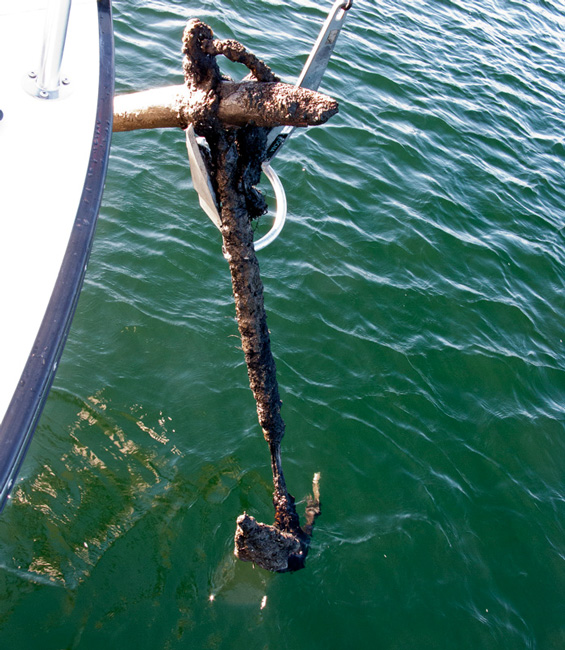
The anchor was about 5' tip to tip across the flukes with a shank that reached from below the waterline to as high I could get the anchor....about 6 or 7 feet. The wooden stock or cross piece was about 5" dia. wood with one side intact and the other partially rotten. The crown ring was 6" dia. about 1" thick with a short piece of chain. I was amazed the windlass could manage to lift it as it must have weighed close to 1000'
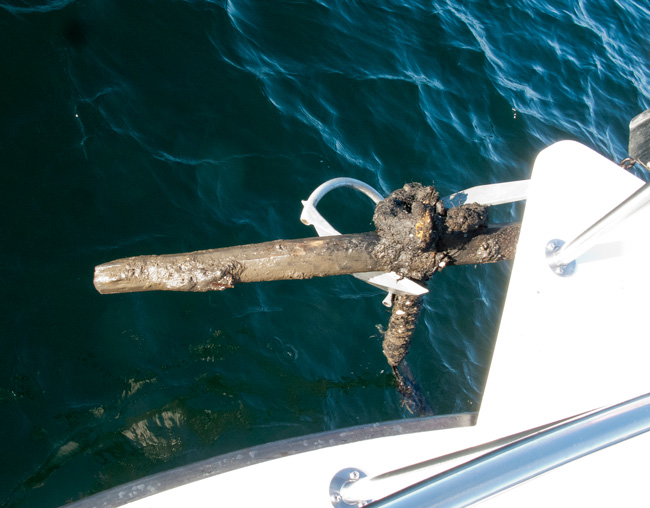
Getting it off was the next challenge - eventually I suspended it from the boat with dock lines and slowly lowered the two anchors into the water and the Rocna dropped free until the old anchor was suspended from the boat. Lot of load on the dock lines but managed to uncleat them and the anchor returned to its grave. We dropped it right in the middle of the Cove where nobody is likely to anchor. Looking at the way the anchor was rusting, it was definitely made of wrought iron probably around the early 1800s.
On our way after an hour delay we were soon out in open water heading down the East Shore with a strong wind out of the northwest at 15-20 kts, waves on the bow with 2-3 foot waves but well spaced out, probably 8 seconds apart. We had a reasonably comfortable ride, running faster than normal at just over 9 kts but with a lot of spray. The trade off will be a lot of salt dried on the boat by the time we get to Halifax.
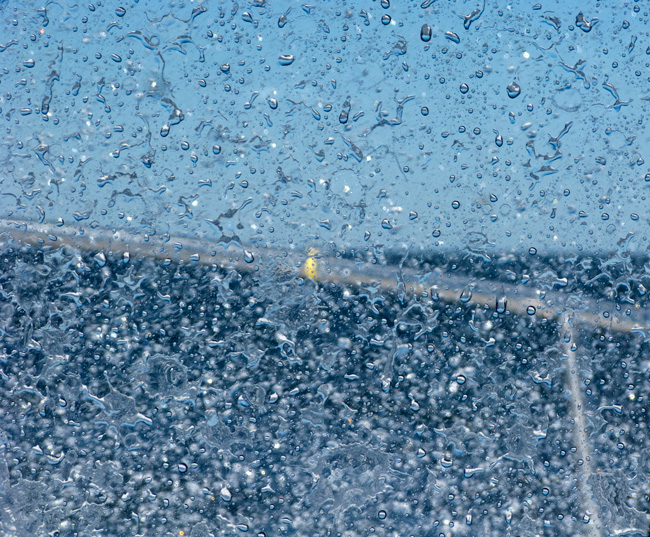
The View Between Wiper Sweeps
We had an uneventful ride with only one fishing boat sighted paralleling us for some time before we arrived in Halifax.
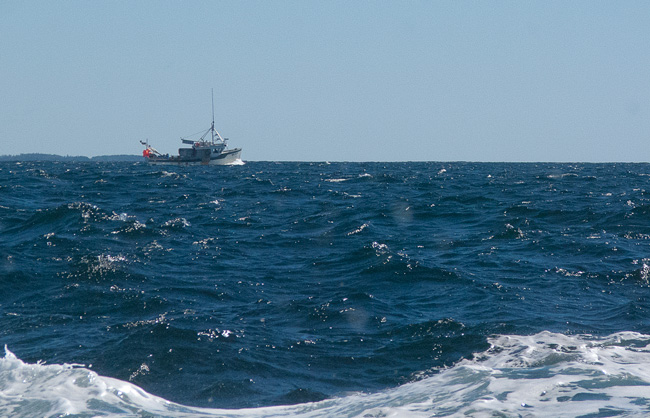
Halifax is the capital of the province of Nova Scotia with a metropolitan area population of 390,000 in 2011, with three quarters in the urban area centred on Halifax Harbour. The city is a major economic centre in Atlantic Canada with a large concentration of government services and private sector companies. Major employers and economic generators include the Department of National Defence, Dalhousie University, Saint Mary's University, the Halifax Shipyard, various levels of government, and the Port of Halifax. Agriculture, fishing, mining, forestry and natural gas extraction are major resource industries found in the rural areas of the municipality.
Historically, the city has always had a military background beginning with the 1746 British government sponsored plan in North America, focused on present-day Halifax. This settlement was undertaken for a number of reasons, including countering the Catholic presence throughout Acadia and the French military presence at Louisbourg, but more importantly exploiting the rich cod fishery. In 1749 some 2,500 settlers, mostly poor and recruited mainly from England, arrived, led by Colonel Edward Cornwallis. Cornwallis selected Chebucto as the site of the new settlement because of its fine ice-free harbour, the second largest in the world. First named Chebucto, it was renamed Halifax shortly after in honour of Earl of Halifax and Chief Lord of Trade and Plantations, who masterminded its settlement. The first settlers had free building lots, but few houses were completed before winter. While some people stayed aboard ship and some others died, almost 1,000 departed for Boston and other US destinations.
However, the buildup American Revolution (1775-83) led the British to reinforce its military presence at Halifax and also brought an influx of Loyalist refugees. To guard against Mi'kmaq, Acadian, and French attacks on the new Protestant settlements, British fortifications were erected in Halifax (Citadel Hill) (1749), Bedford (Fort Sackville) (1749), Dartmouth (1750), and Lawrencetown (1754). Military presence continues today.
After stopping at the Royal Nova Scotia Yacht Squadron for a pump out we found our slip at the Armdale Yacht Club on the backside of the marina with excellent protection all round.
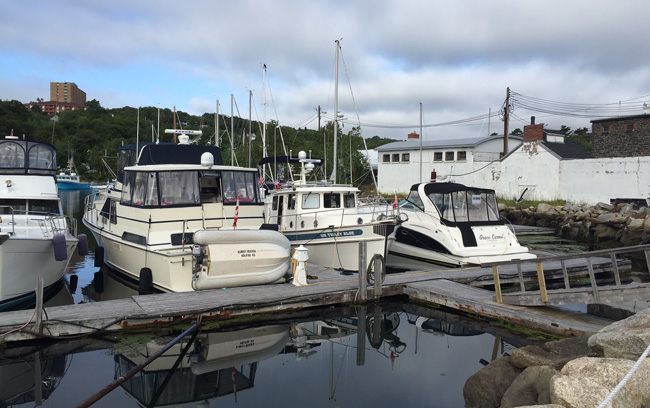
This club had very good reviews and we found everyone to be very helpful. One of the members had painted this view of the club from the Northwest Arm... a very fine watercolor.
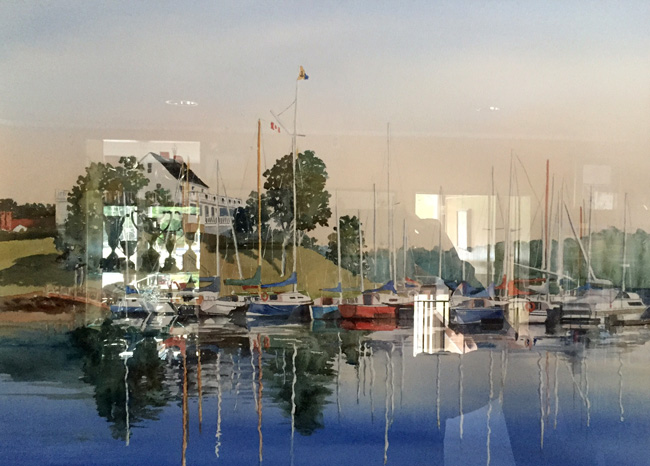
Armdale Yacht Club (excuse reflections)
As we thought the boat was encrusted with salt, probably the worst we had seen so far. Every surface was thick with salt ... we could have gone into the sea salt business by just scraping the boat! A couple of hours of work cleaned most of it off but we could see the start of some corrosion on lesser quality stainless steel; Judy will be working with the Autosol soon the clean it up.
We were met at the dock by our next door neighbors, Bert and Karen on their newly acquired Tollycraft 45; they are getting ready to head south for the winter and we spent some time chatting with them about our trip. When we enquired about grocery shopping (a good distance away), Karen kindly offered to run us the couple of miles to the supermarket and waited while we gathered a few items up quickly. We will owe so many favors at the end of this trip at this rate! She even offered to let us use their washing machine at their apartment but we were OK for a while and can hand wash what we need.
As we got back to the boat, a couple approached our boat and asked us if we knew Dean Phelps. (Dean is someone we have spent time with in the North Channel for several years). Bill Prior and his partner, Lisa Driscoll, lived in Harbor Springs near Dean's home port and know him well. They sold their home and have been living on their boat, a Kadey Krogen 48' North Sea, for the past two years; they are slowly working their way south for the winter.
Armdale Yacht Club has had several locations in its past but is now located on Melville Island which has a long history since Europeans arrived, being a family estate in 1732, hospital, quarantine station, military prison, prisoner of war camp, recruit training station for the British Foreign Legion, ammunition depot and now a yacht club. Wayward soldiers and sailors were jailed here as early as 1803. Beginning in 1808, French prisoners began arriving during the Napoleonic Wars. American prisoners captured during the war of 1812 also paid a reluctant visit to what by then had been named Melville Island. The stone prison (above) on the site was used during the first World War to house German prisoners of war.
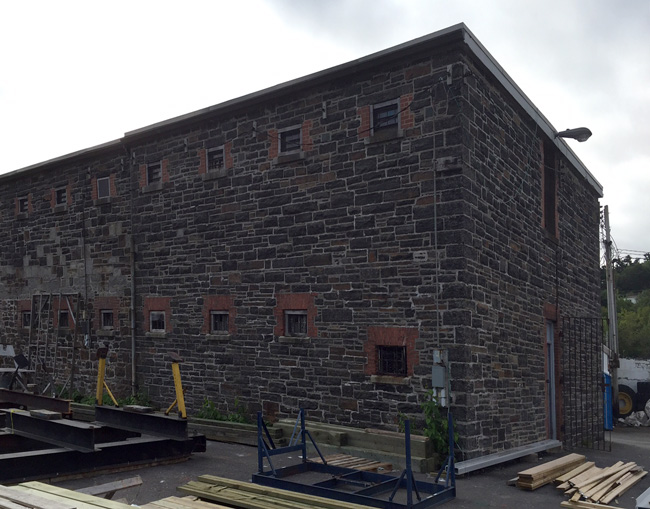
Today, 32 lucky members get to rent a previous "cell" for storage purposes.
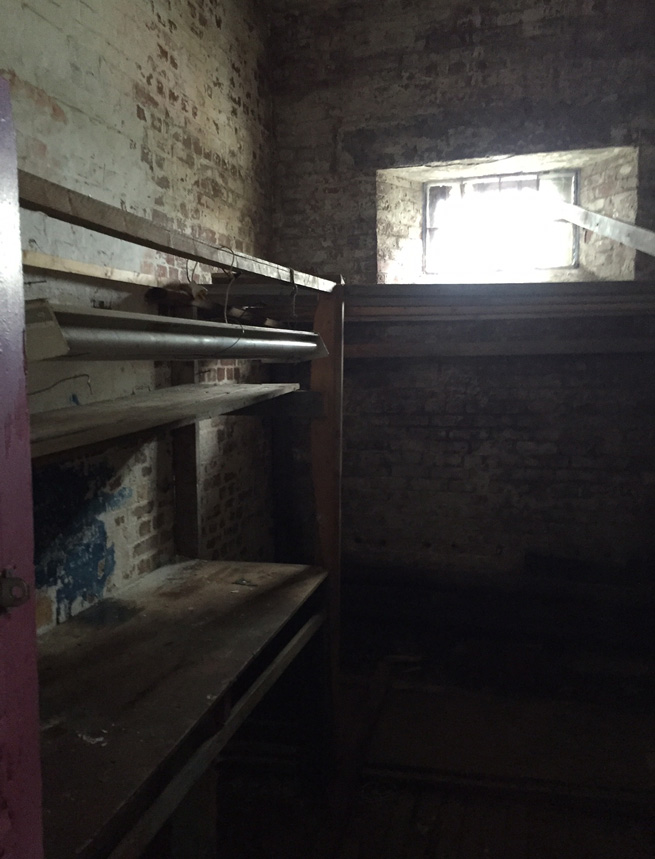
A Grim Place With No Heat for the Prisoners
Wednesday, August 24
Today was time to catch up with the rest of the group who had already been here a day - Tug'n on a mooring ball at Armdale and Wings at a dock in Halifax.
As we were leaving to get the bus into town, Judy spotted a guy from a nearby dock with a bundle of laundry in front of us so we asked him where he was taking it (we needed to do some laundry). He was going to the Royal to use their machines as there were no close. Al turned out to be a sailor from Montreal living on his boat for the summer. Born in French Angola, he had moved to Canada many years ago. He kindly offered to drive us into town about 20 minutes away and took us on a short guided drive on the way, pointing out places of interest and the good restaurants.
We met up with Jan and Bob for a very good breakfast at the Bluenose II Restaurant ... the place for breakfast downtown ... a couple of blocks up from the Maritime Museum of the Atlantic. Well fortified, we headed for the Museum, a major attraction in the town where we talked to the staff about the anchor we had dredged up. in their opinion, it was probably from the late 1700/early 1800s based on the wooden stock (the crosspiece at the top of the anchor) ... quite historic. We will send them the coordinates of where we dropped it in case they wanted to try and retrieve it.
The Museum was well worth a visit combining all aspects of marine related Nova Scotia and the Atlantic Region and Halifax history. Here are a few photos ...
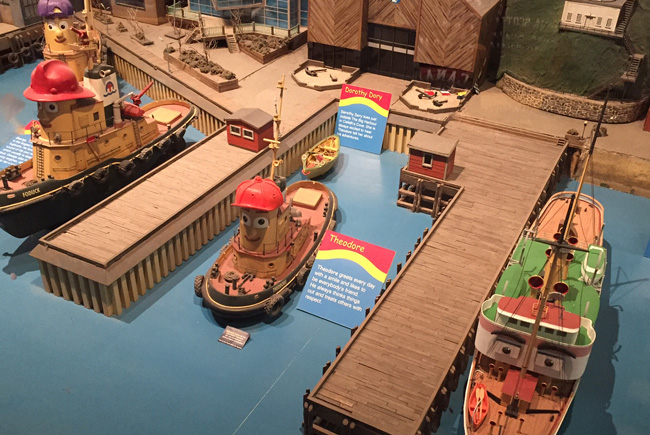
The Original Set from Theodore Tugboat
Theodore was a childrens' TV program that began in 1989 on Canadian TV; the stories tell the adventures of Theodore and his many nautical friends in the Big Harbor modeled on Halifax. It is very similar to Thomas, the Tank Engine, with each boat having their own personalities and roles in the community. Outside they have full size version of Theodore and it makes several cruises a day.

One part of the Museum dealt with the dangers faced by seaman and attempts to improve safety including lighthouses, aids to navigation, volunteer lifeboat crews. The Nova Scotia coastline was the most dangerous in North America with at least 10,000 shipwrecks; some hold that it is at least double
that number. Each dot on the map below represents a significant shipwreck.
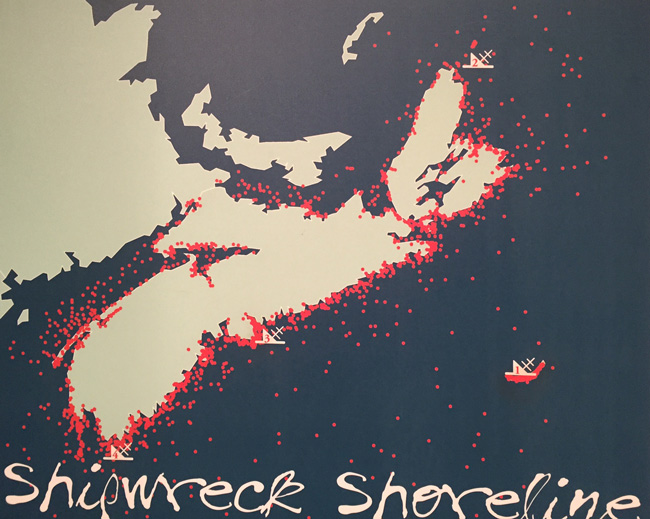
With its strong links to boat building, Nova Scotia designers and boat builders are highlighted by a collection of small rowing and sailing boats indoors.
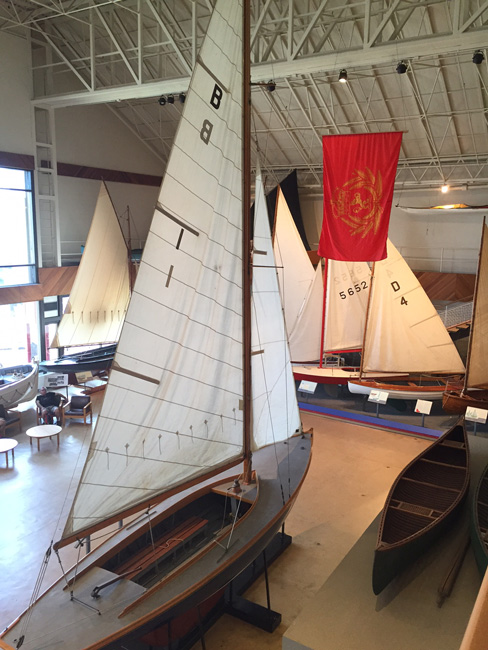
The Museum has an excellent collection of ship models, some donated, some built a long time ago, and some built or refurbished by a cadre of model boat builders that volunteer at the museum. One of particular interest was built by a French prisoner at the prison at Armdale Yacht Club in the 1790s during the Napoleonic War. Made from pork and beef bones, likely saves from his dinner plate it was probably sold during one of the days the prison was open to the public.
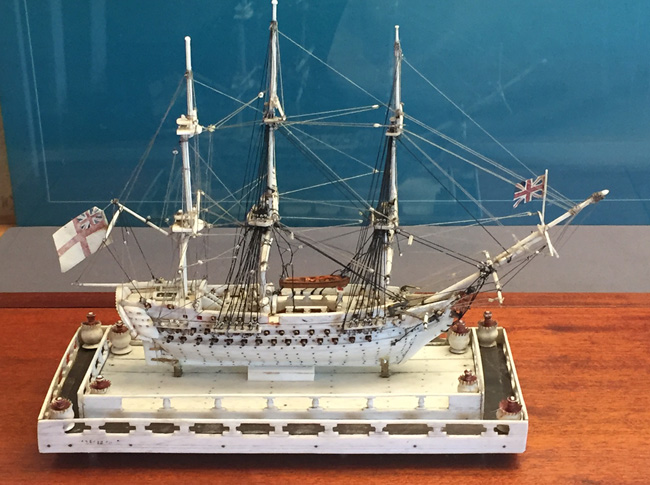
Model of 74 Gun British Warship (about 18" long)
One section of the Museum tells the story of the Halifax Explosion. On December 6, 1917, the Mont Blanc a fully laden munitions vessel, was heading to the Bedford Basin area of Halifax Harbor to join an Atlantic convoy when at 8:45 am, the Imo, a Norwegian freighter, collided with it. Fire quickly broke out and just seconds before 9:05, the Mont Blanc exploded.
The blast was the largest man-made explosion prior to the development of nuclear weapons,releasing the equivalent energy of roughly 2.9 kilotons of TNT. The pressure wave raced outward at 2500 mph and was felt 400 miles away. 1600 people were killed instantly with another 9000 injured (350 later died). Those close who saw the explosion were blinded. Nearly all structures within a half mile radius, including the entire community of Richmond, were obliterated. A pressure wave snapped trees, bent iron rails, demolished buildings, grounded vessels, and white hot fragments of Mont-Blanc rained down for miles around.
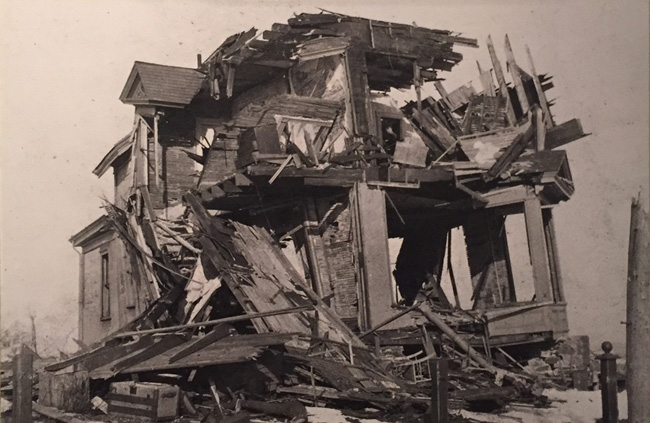
A House Situated Almost a Mile From the Blast Site
One of the Mont-Blanc's anchors weighing over 1000 lbs landed at Armdale 2 miles away, Its Forward 4" gun landed over three miles away. Hardly a window in the city proper survived the blast. Across the harbour, in Dartmouth, there was also widespread damage. A 60' tsunami created by the blast wiped out the community of Mi'kmaq First Nations people who had lived in the Tuft's Cove area for generations.
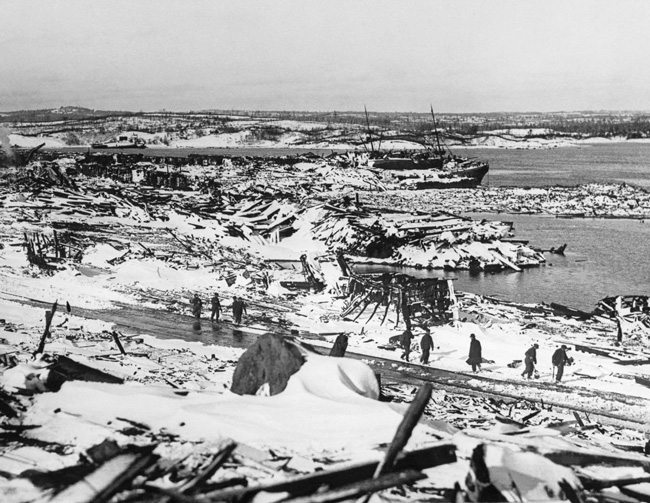
Firefighter Billy Wells, who was thrown away from the explosion and had his clothes torn from his body, described the devastation survivors faced: "The sight was awful, with people hanging out of windows dead. Some with their heads missing, and some thrown onto the overhead telegraph wires." He was the only member of the eight-man crew of the fire engine "Patricia" to survive.
The death toll could have been worse had it not been for the self-sacrifice of an Intercolonial Railway dispatcher, Patrick Vincent Coleman, operating at the rail yard about 750 feet from Pier 6, where the explosion later occurred. He began to flee but remembered, however, that an incoming passenger train from Saint John, New Brunswick, was due to arrive at the rail yard within minutes. He returned to his post and continued to send out urgent telegraph messages to stop the train. "Hold up the train. Ammunition ship afire in harbor making for Pier 6 and will explode. Guess this will be my last message. Good-bye boys." Coleman's message was responsible for bringing all incoming trains around Halifax to a halt saving well over 300 passengers from certain death.
Relief efforts began almost immediately, and hospitals quickly became full. Rescue trains began arriving from across eastern Canada and the north-eastern United States, but were impeded by a blizzard which dumped 16" of snow that evening.
The Cunard Line, the greatest marine travel firm in modern history, is deeply rooted in Halifax. Samuel Cunard, the line's founder was born in the city in 1787 and lived most of his life here. Cunard was a great entrepreneur engaged in a range of trades in colonial Nova Scotia: selling timber overseas, trading local goods in the West Indies and bring their goods back to America and Canada, whaling, developing coal mines and building and operating ships. His successors were responsible for developing the passenger line carrying passages across the Atlantic and eventually around the world in such ships as the Mauritania, Lusitania, Aquitania, Queen Mary, and the Queen Elizabeth.
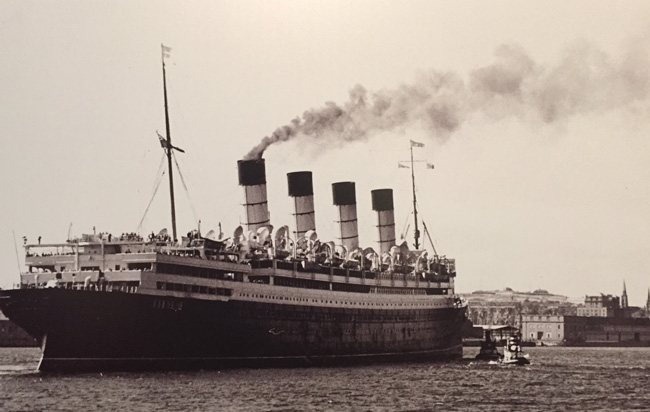
One of the ...ani as
The Museum has an extensive collection of Cunard materials and artifacts and an outstanding models of some of their famous ships.
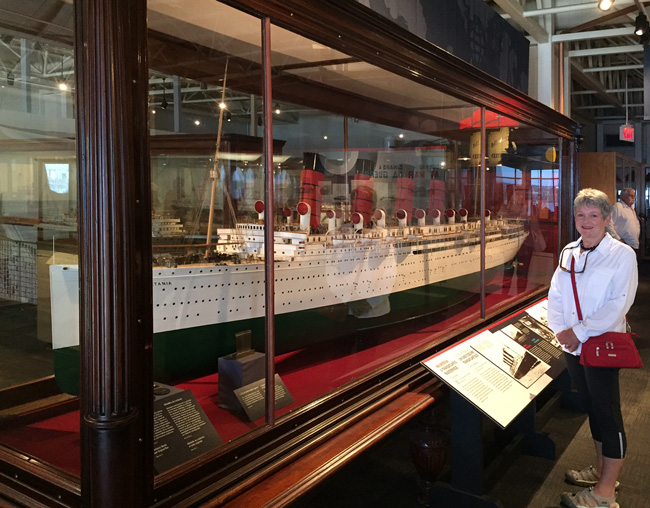
The Mauritania - Holder of the Blue Riband for 17 Years for an East to West Atlantic Crossing
Halifax was the focal point for the Atlantic convoys of merchant ships during the earlier part of World War II until the USA joined in. The Harbor is the deepest, wide, ice-free harbour with minimal tides and is two days closer to Europe than any other North American East Coast port. 377 convoys sailed from the city comprising over 20,000 ships in total; the largest convoy was over 100 ships.
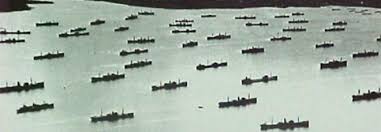
Part of A Convoy in Halifax Harbor
On occasions over 250 vessels were docked or anchored in the harbor. The Museum has a large display dedicated to its role in maintaining supplies to Europe with models, maps and videos.
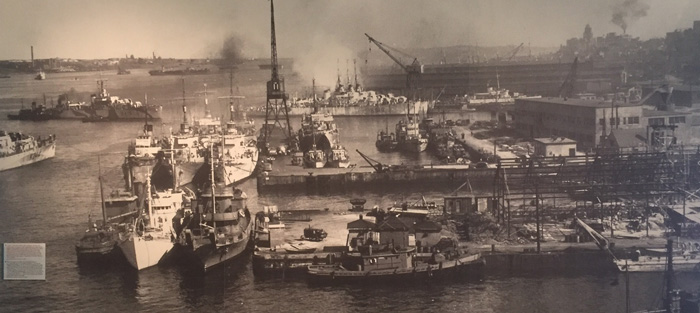
We spent a good four hours at the Museum before the call of lunch and could have used much more time.
The afternoon was taken up with wandering around some of the historic parts of the waterfront and enjoying some Cows ice cream (see PEI blog) before meeting up with the rest of the gang at Wings some shopping and a run to catch the bus back to Armdale, the boat, and dinner.
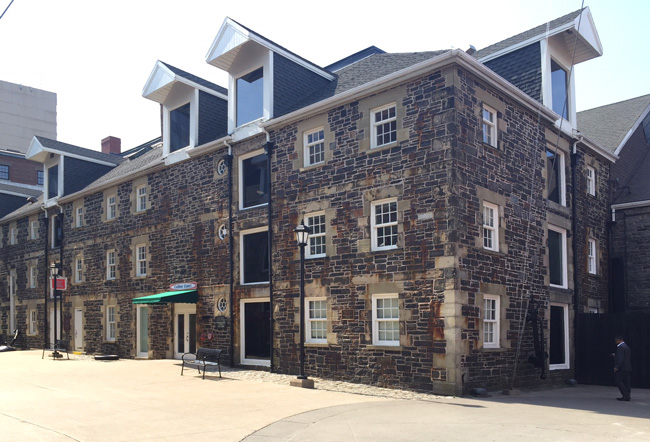
The Former Halifax Banking Company - 1826
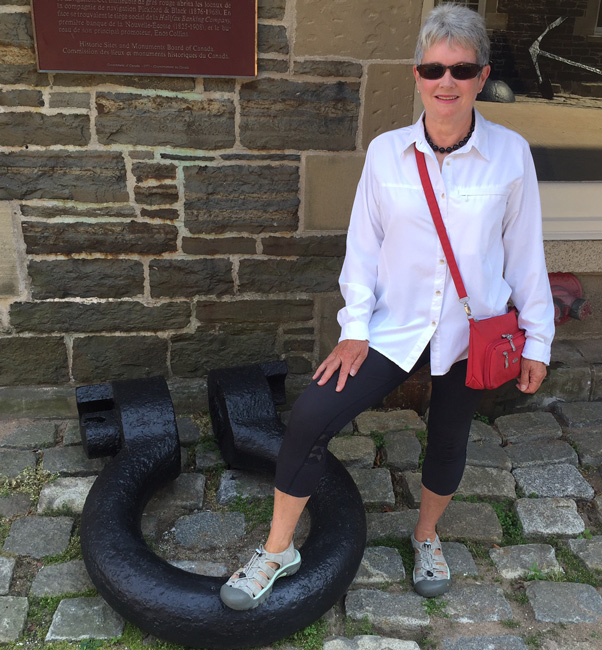
Big Shackle, Eh!
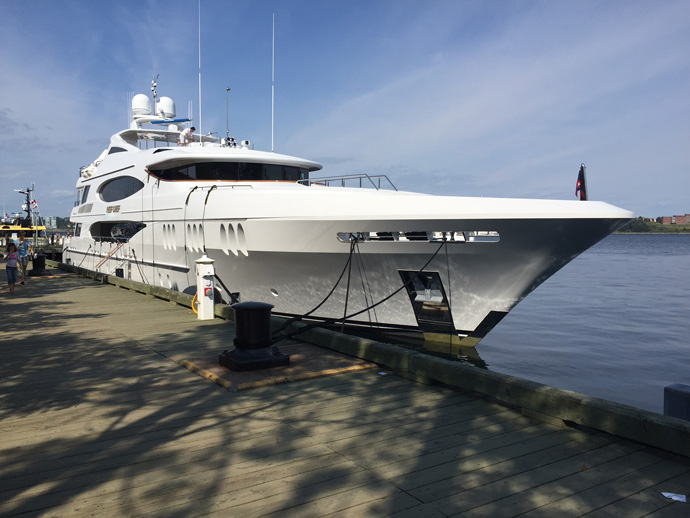
After getting off the bus we had to cross a busy intersection with bad visibility and they had a novel way to help protect pedestrians ... flags on either side of the road to carry and wave as you cross the road.

After dinner, we were entertained by the two resident ospreys which would perch on the sailboats' masts looking for mackerel, their favorite food. They would often balance precariously on an area less than two square inches before taking off, circling around and then plunging from 60 feet into the water and, if successful, emerging ten seconds later with a nice mackerel grasped in their talons and fly up to another mast where they would devour their meal. Glad we do not have a sailboat as they make quite a mess below!

Thursday, August 25
Great weather again as we left with Fran and Stephen to go to the Citadel, the fort located on the hill overlooking Halifax and its harbor.
The present day Citadel stands on the site of three former different forts. Today's Citadel was built from 1828 to 1856 and was intended to deter an overland assault on the city and the dockyard which was the home of the British Navy in the north. It also had the capability to defend the harbor in conjunction with a series of forts in the area and was so strong that no enemy every dared attack. The British garrison was ultimately withdrawn in in 1906 in response to growing tensions in Europe leading up to the First World War. The Citadel continued to serve an important role within the Canadian military. During two world wars, the Citadel was used for training soldiers being sent overseas.
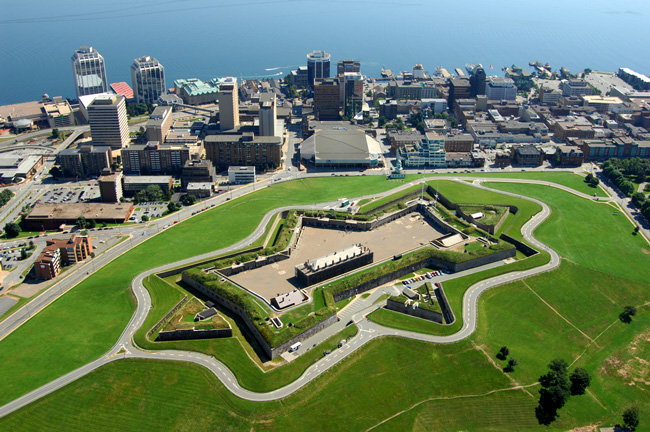
The Citadel with its Classic French Star-Shaped Design
In 1952, the fort was declared a National Historic Site, ending its military career and it was transferred to Parks Canada. Today, it is a major tourist attraction in Eastern Canada. The Citadel has the 78th (Highland) Regiment of Foot (Ross shire) and the 3rd Brigade Royal Artillery of 1869 re-enactors stationed in the Citadel performing demonstrations throughout the day. Uniformed pipers and drummers who would have been non-military personnel back in the day, hired by the regimental officers, also practiced and performed.
We had a great informative tour by ...

Sergeant in Drill Uniform
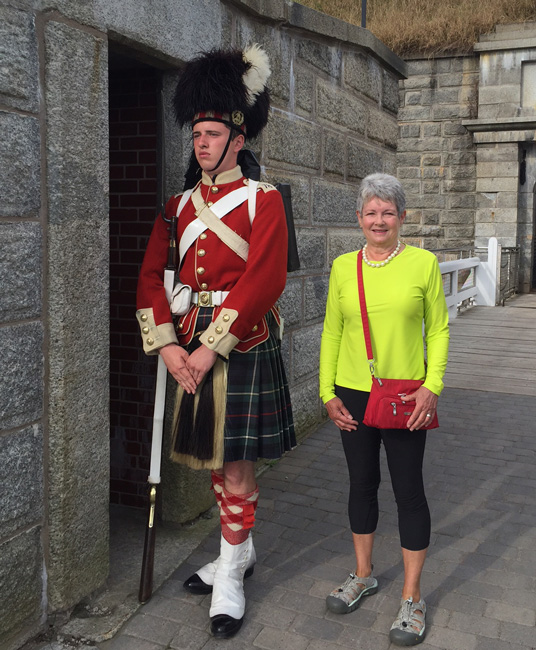
Sentry in Full Dress as Worn in the Field
As much as possible, they re-create the life of a typical soldier in the mid 1800s including hours of drill on the parade ground and musket practice.
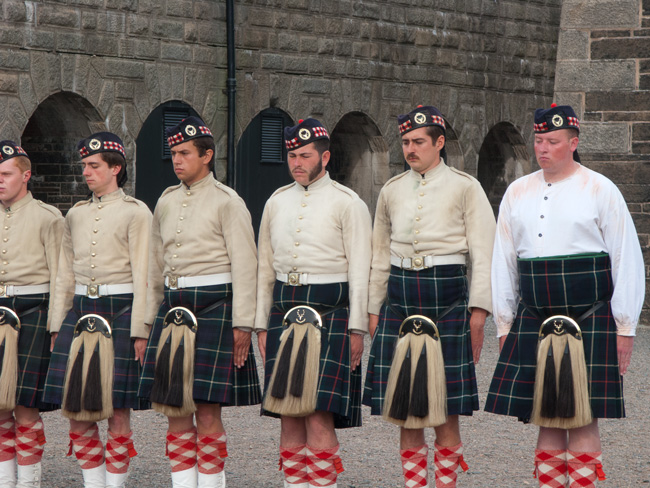
A Happy looking Bunch on Parade
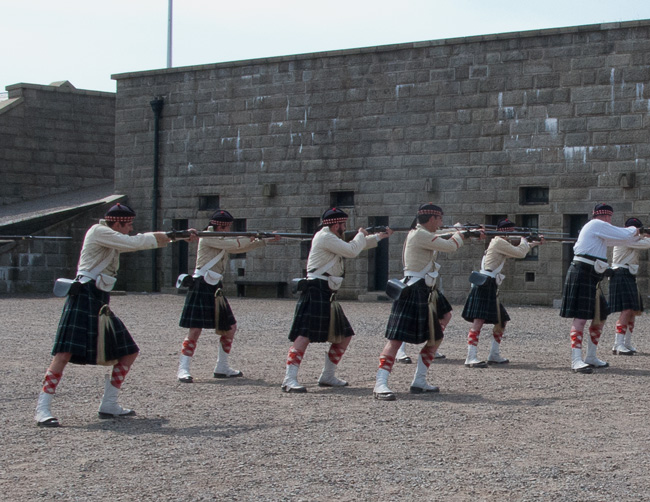
Try Holding a 10lb Musket As Long As You Can!
The firing of the Noon Gun each day, except for Christmas Day, marks noon time in Halifax, a local tradition since 1857. The present noon gun is a reproduction 12 pounder, smooth-bore muzzle loading gun used during the reign of King George III (1760-1820). Dressed as the 3rd Brigade Royal Artillery of 1869, the gunners demonstrate the drill to fire the gun.
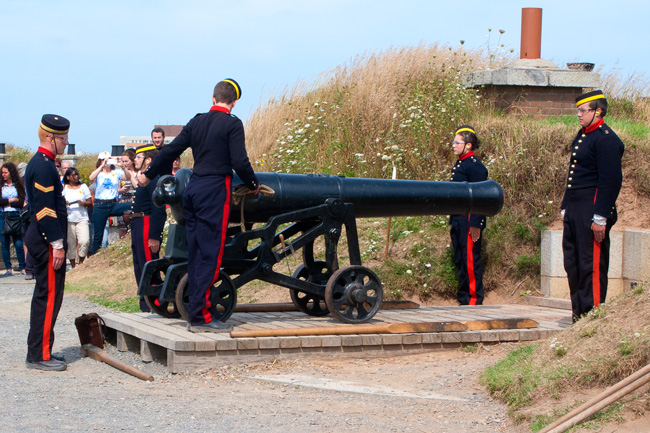
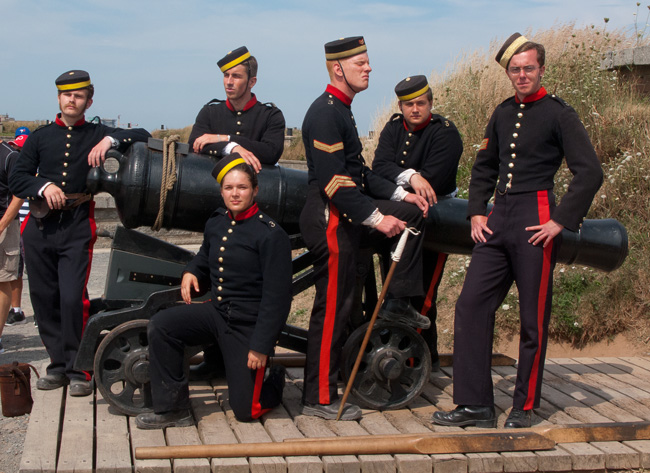
A Classic Pose after A Successful Firing
Parks Canada has put together a good First World War exhibit in part of the Citadel (staffed by an young soldier and a nurse) that includes the stories of 27 Halifax residents who fought in the War, videos, and a reconstruction of a trench system you can walk through. Nowhere near the real thing but we would not want to be walking through knee deep mud with bullets flying overhead.
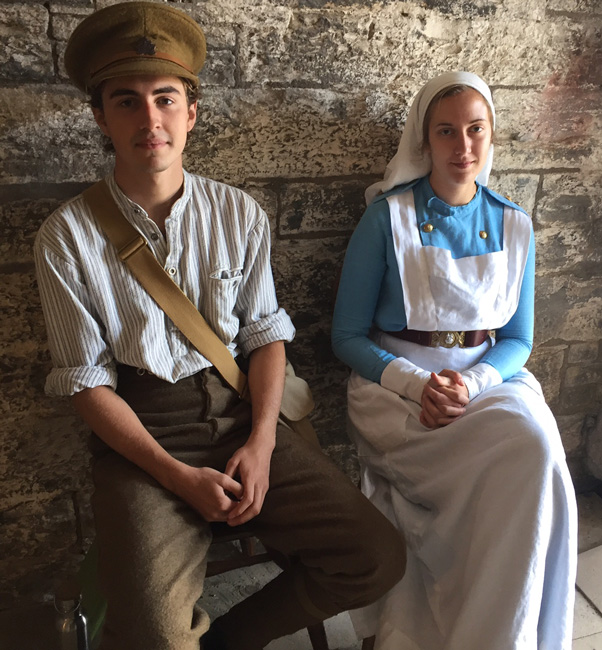
During our visit, there was almost continuous music being played by one of the several pipers. We later talked with him and he had only playing for three years but had a musical background. The pipers have their own training program at the Citadel and typically practice four hours a day.

This ended our day at the Citadel and we headed off for a long lunch, a very good pizza, at Mano's near Bishops Landing.
Friday, August 26
Today we took a break from sightseeing and did a couple of errands, visited the best marine store nearby, the Binnacle, which is a thriving online and brick front store, washed a lot of laundry, did boat jobs and computer work, hung a new US flag, and filled the fuel tanks with inexpensive (for Canada) diesel. The day soon disappeared.
Saturday, August 27
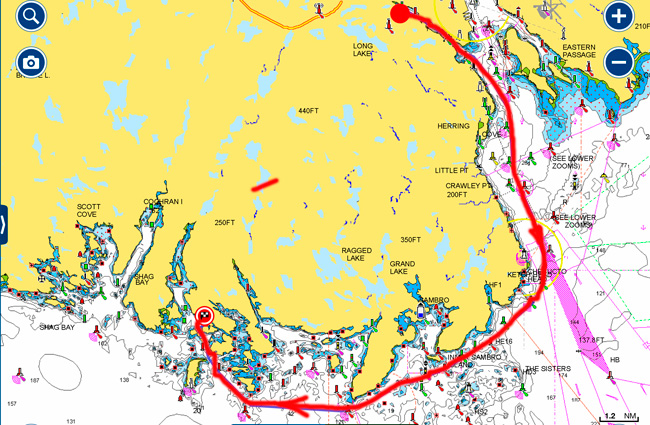
Halifax to Rogues Roost - 25nm
After bidding Bert and Karen goodbye and good luck with their cruise, we all left Halifax' Northwestern Arm under sunny skies for Rogues Roost. The Arm is home to many of the rich and famous of Halifax.
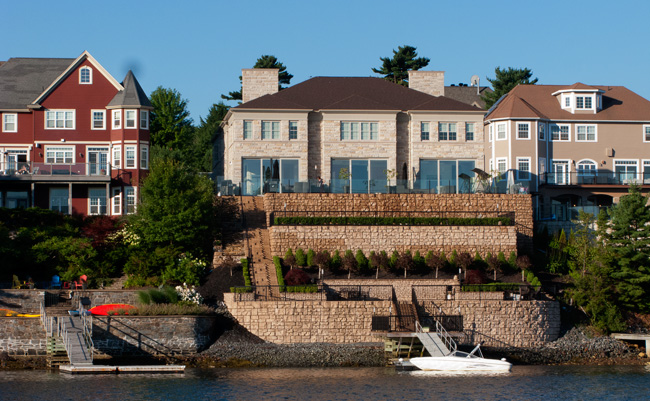

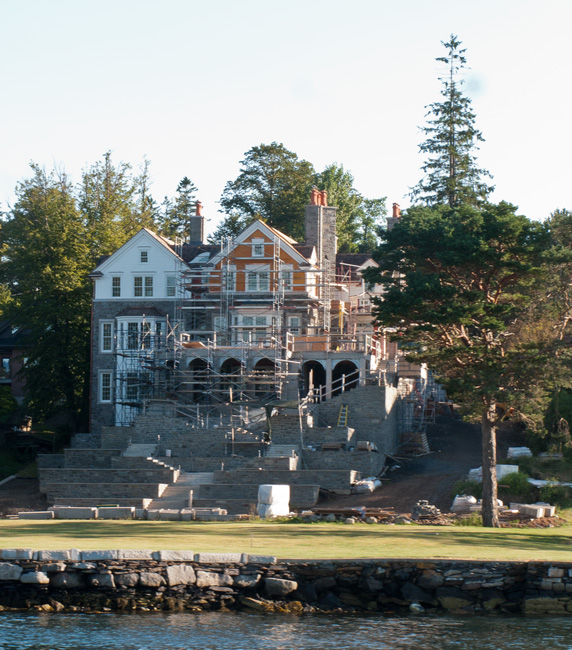
Another One on the Way!
At the end of the Arm we made a sharp turn at the rugged Chebucto Head where we saw the freighter below.
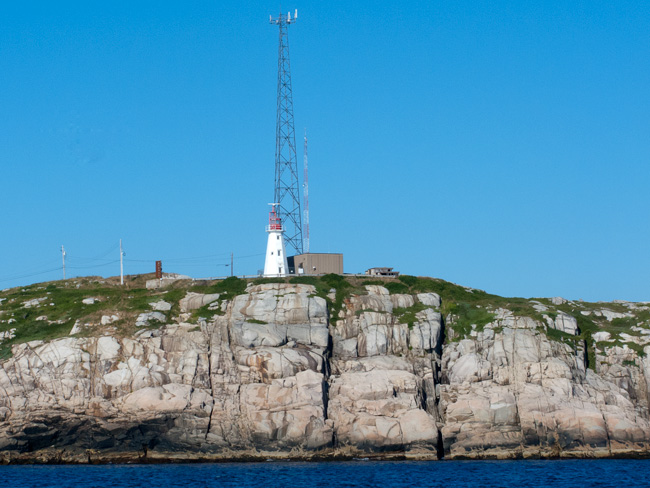
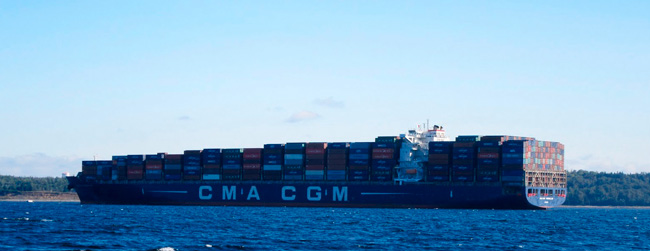
This freighter passed us and was so heavily loaded with containers, that the bridge could probably not see closer than a mile away!
Rogues Roost has been called by many the best anchorage in Nova Scotia. The area is mostly covered in heathers, low grasses and evergreens; berries abound in nearly all seasons. The landscape is rough, and barren with glacial striations noticeable on the top of Roost Island and surroundings island. Deep narrow channels were carved out by retreating ice sheets tens of thousands of years ago. In many areas, the topsoil has eroded to weather. Large erratic boulders and glacial anomalies salt and pepper the landscape.
This beautiful anchorage lies to the north of a very narrow entrance between Roost Island and several small islands to its north. The anchorage to the south is commonly called Snow's Cove after John Snow, a longtime stalwart of the Armdale Yacht Club who died tragically in 1970 in his car sliding down the hill at the Club into icy water by his own slip. The Cove was his favorite anchorage and a bronze plaque is affixed to a rock at its entrance. It reads:
“In Memory of John Snow, 1914-1970; keen small boat enthusiast, founding member of NS Schooner Association, leader of many organized cruises, an outstanding shipmate; erected by his many friends on this the site of his favorite anchorage, Snow’s Cove of Rogue’s Roost, ‘…and all I ask is a merry yarn from a laughing fellow rover, and quiet sleep and a sweet dream when the long trick’s over’; Erected July 15, 1972”.
According to some websites, the Roost was popular as a hideout for privateers during the War of 1812. Legend has it that Young Teaser, a soldier and his boat of the same name, now haunt the route.
The entrance was a little tricky and the Cruising Guide was very useful in avoiding the rock at the entrance. Snow's Cove is a little tight for many boats so we headed to the larger north area where we found only two other boats. Care is needed anchoring here with depths as low as a few feet at low tide but we found a good spot.
The View To our East
The area is very popular with boaters from Halifax and the local area and, at one point, there were fourteen boats all safely anchored here. There are three mooring buoys, one of which is the Royal NSY Squadron. The other two are "private". We attempted to find the path to hike up to the high point which is reputed to have a commanding view over the outside Bay as far as Prospect, a nearby town but were not successful. The area is mostly covered in heathers, low grasses and evergreens. Berries abound in nearly all seasons. The landscape is rough, and barren. Glacial striations are noticeable on the top of Roost Island and surrounding islands. Deep narrow channels were carved out by retreating ice sheets tens of thousands of years ago. In many areas the topsoil has eroded to weather. Large erratic boulders and glacial anomalies salt and pepper the landscape.
Many boats left later in the day so our peaceful anchorage was quiet for the night.
The Nova Scotia Nature Trust last year worked out an arrangement with the private owners of a key area of of Rogues Roost to protect this land and to fold it into the 1200 hectare Rogues Roost Wilderness Area. This was completed in June 2016.
Sunday, August 28
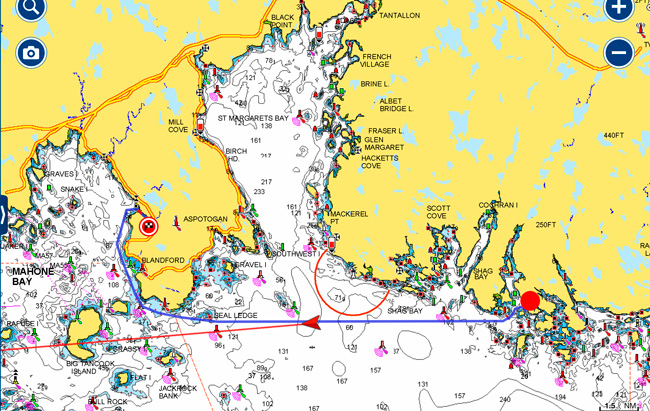
Rogues Roost to Deep Cove - 24 nm
A good calm night as a clear sunny day greeted us as we pulled the anchor for a three hour run to Deep Cove in Mahone Bay. We soon made the turn into the bay and entered the Cove which was a highly rated anchorage according to all of the Guides. It was described as long and narrow with a very high level of protection. The Guides proved to be correct ... the Cove was about a mile long and only 300 yards wide, opening up at the far end into a nice basin; truly a hurricane hole. Although the description noted the presence of houses on the steep wooded banks, we were a little disappointed to find that a number of condominiums had been built at the end and the anchorage was crowded with mooring balls. There was room to anchor our three boats but we had to drop in 25 feet of water so had to allow for quite a swing radius.
We enjoyed the sunny afternoon on deck with quite a bit of boat traffic. Later in the day a couple of ospreys hunting for food kept us entertained.
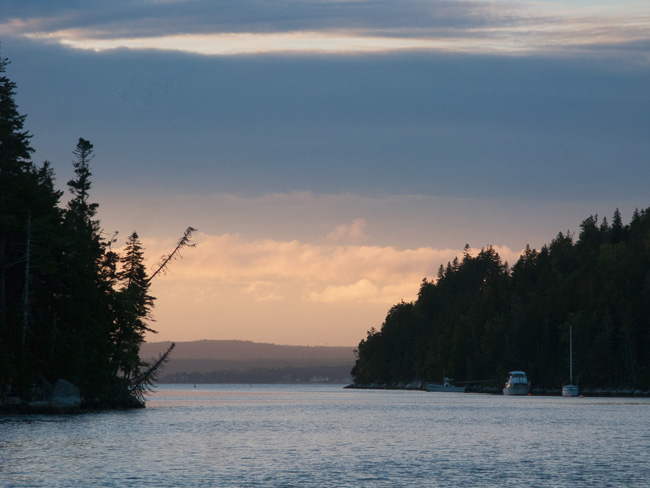
May 16 - 22 |
May 23 - 29 |
May 30 - Jun 5 |
Jun 6 - 12 |
Jun 13 - 19 |
Jun 20 - 26 |
Jun 27 - Jul 3 |
Jul 4 - 10 |
Jul 11 -17 |
Jul 18 - 24 |
Jul 25 - 31 |
Aug 1 - 7 |
Aug 8 - 14 |
Aug 15 -21 |
Aug 22 - 28 |
Aug 29 - Sep 4 |
Sep 5 - 11 |
Sep 12 - 18 |
Sep 19 - 25 |

